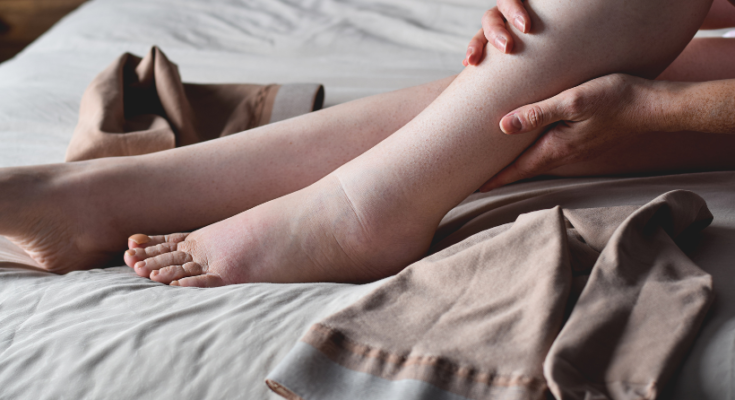Lymphedema Symptoms: Lymphedema is a chronic condition characterized by the accumulation of lymphatic fluid in the body tissues, leading to swelling, most commonly affecting the arms or legs.
It can result from congenital issues (primary lymphedema) or damage to the lymphatic system due to surgery, radiation, infection, or trauma (secondary lymphedema).
What is Lymphedema?
Lymphedema is a chronic medical condition characterized by the accumulation of lymphatic fluid, leading to swelling, most commonly in the arms or legs. This occurs when the lymphatic system, which is responsible for removing excess fluid from tissues and aiding immune function, is damaged or blocked. The swelling from lymphedema can range from mild to severe and may impact daily activities and quality of life by increasing the risk of infections and causing pain or discomfort.
Distinction Between Primary and Secondary Lymphedema
Lymphedema is classified into two main types: primary and secondary, each with distinct causes:
- Primary Lymphedema: This type is less common and is typically caused by congenital malformations of the lymphatic system. It can manifest at birth, during puberty, or in adulthood, with no apparent external cause. Primary lymphedema is often due to genetic factors and can be seen in conditions such as Milroy’s disease or Meige’s disease.
- Secondary Lymphedema: More prevalent than primary lymphedema, secondary lymphedema develops as a result of damage to the lymphatic system. Common causes include surgery, radiation therapy, infection, or trauma that affects the lymph nodes or lymph vessels. It is frequently associated with cancer treatments, particularly for breast cancer, where lymph nodes are often removed or damaged.
Statistics on Prevalence and Risk Groups
Lymphedema affects a significant number of individuals worldwide, though precise statistics can vary based on the population and region studied:
- Prevalence: It is estimated that up to 10 million Americans and hundreds of millions globally suffer from lymphedema. In cancer survivors, secondary lymphedema affects approximately 20% of individuals, depending on the type of cancer and treatment received.
- Risk Groups: While anyone can develop lymphedema, certain groups are at higher risk:
- Cancer Patients: Especially those who have undergone surgery or radiation therapy involving lymph nodes.
- Older Adults: Age-related decline in health and the lymphatic system’s functionality increases susceptibility.
- Individuals with Obesity: Excess weight can strain and damage the lymphatic system.
- Patients with Rheumatoid or Psoriatic Arthritis: Inflammatory conditions can lead to complications in lymphatic function.
- Genetically Predisposed Individuals: Those with family history of lymphedema are at increased risk.
However, understanding lymphedema, its types, and the groups at higher risk helps in early diagnosis and effective management, reducing the overall burden of the disease and improving the quality of life for those affected.
Causes of Lymphedema
Understanding the causes of lymphedema is essential for effective management and treatment. Here, we delve into the genetic factors contributing to primary lymphedema, the secondary causes like surgery, radiation therapy, and cancer, as well as other contributing factors such as infections and obesity.
Genetic Factors Contributing to Primary Lymphedema
Primary lymphedema is often linked to genetic abnormalities that affect the lymphatic system’s development. Several genetic factors include:
- Mutations in the VEGFR3 gene: These mutations can lead to improper development of the lymphatic vessels.
- FOXC2 gene mutations: These are associated with lymphedema-distichiasis syndrome, where individuals have lymphedema and abnormal eyelash growth.
- GJC2 gene mutations: Linked to lymphedema and spinal cord anomalies.
- CCBE1 gene mutations: Essential for lymphangiogenesis, mutations in this gene can disrupt normal lymphatic vessel formation.
These genetic abnormalities can be inherited or occur spontaneously, leading to varying onset times of lymphedema, from birth (congenital lymphedema) to later in life.
Secondary Causes
Secondary lymphedema results from damage to the lymphatic system or from its obstruction. Key causes include:
- Surgery: Surgical procedures, especially those involving lymph node removal such as mastectomies, can disrupt normal lymphatic drainage.
- Radiation Therapy: Often used in cancer treatment, radiation can damage lymph nodes and vessels, leading to lymphedema.
- Cancer: Tumors can obstruct lymphatic pathways either by their presence or by spreading to lymph nodes (metastasis), impeding fluid flow.
Patients undergoing cancer treatment are at a higher risk and should monitor for symptoms of lymphedema to manage them promptly.
Other Contributing Factors
In addition to genetic predispositions and medical treatments, other factors can influence the development of lymphedema:
- Infections: Bacterial and fungal infections can cause inflammation of lymph vessels, particularly in tropical areas where filariasis is common.
- Obesity: Excessive body weight can strain and overburden the lymphatic system, exacerbating or even initiating the onset of lymphedema.
Recognizing these factors is crucial for both prevention and early intervention, which can significantly improve quality of life for those affected by lymphedema.
Symptoms of Lymphedema
Understanding its symptoms can aid in early detection and management. Below, we outline the early and advanced symptoms of lymphedema, providing clear indicators of the progression of this condition.
Early Symptoms of Lymphedema
- Slight Swelling: One of the earliest signs is a mild swelling that may come and go. It often affects a part of the arm or leg, including fingers and toes.
- Feeling of Heaviness or Tightness: Individuals might feel a sensation of heaviness or tightness in the affected limb, which is not associated with pain initially.
- Limited Range of Motion: There may be a noticeable decrease in flexibility or range of motion in the affected limb, making it harder to move.
- Tight-fitting Clothing or Jewelry: Rings, watches, or clothing might feel tighter on one side of the body, indicating changes in tissue fluid levels.
- Skin Changes: Early on, the skin may retain a dimple after being pressed for a few seconds (pitting edema).
Advanced Symptoms of Lymphedema
- Increased Swelling: Over time, the swelling becomes more persistent and noticeable, failing to improve with elevation or rest.
- Hardening of the Skin (Fibrosis): The affected area may feel harder to the touch as the skin thickens and loses its normal texture.
- Recurring Infections: Frequent infections, such as cellulitis, can occur due to impaired lymphatic function which affects immune responses.
- Persistent Pain: As the condition progresses, ongoing pain may develop in the affected limb, complicating daily activities.
- Significant Range of Motion Loss: The swelling and fibrosis can severely restrict movement, significantly impacting the individual’s quality of life.
If you notice any of these signs, consulting with a healthcare provider for proper diagnosis and treatment is advisable.
Complications Associated with Lymphedema
Lymphedema, if left untreated, can lead to several serious complications that can significantly impact an individual’s health and quality of life. It is essential to address lymphedema promptly to minimize these risks. Here are some of the potential complications associated with untreated lymphedema:
1. Chronic Inflammation: Continuous swelling can lead to chronic inflammation in the affected area, which can damage the tissue over time.
2. Infections: Patients with lymphedema are at a higher risk of developing infections such as cellulitis or lymphangitis. The excess fluid in the tissues provides an ideal environment for bacteria to grow.
3. Skin Changes: Over time, the skin in the affected area can become thicker and harder, a condition known as lymphostatic fibrosis. This can make the skin more susceptible to injury and infection.
4. Fatigue: The extra weight of the swollen limb and the body’s increased effort to fight infection can lead to chronic fatigue, affecting daily activities.
5. Decreased Mobility: Swelling can significantly restrict the range of motion of the affected limb, leading to decreased mobility and difficulty in performing daily tasks.
6. Psychological Impact: Living with lymphedema can also have a psychological impact, leading to issues such as depression and anxiety due to chronic discomfort and visible differences in appearance.
However, addressing lymphedema early with appropriate treatment can help prevent these complications and improve the quality of life for those affected.
Diagnosis and Recognition of Lymphedema
Proper diagnosis and early recognition are crucial for managing this condition effectively. Here’s how lymphedema is typically diagnosed and why early detection is vital.
How Lymphedema is Diagnosed
- Medical History Review: The first step in diagnosing lymphedema involves a detailed discussion of the patient’s medical history, including any surgeries, radiation treatments, or infections that could have impacted the lymphatic system.
- Physical Examination: A physical exam is conducted to check for signs of swelling, skin changes, and differences in limb size. Doctors may also look for symptoms like a feeling of heaviness or tightness, which are common in lymphedema patients.
- Circumference Measurement: Measuring the affected limb’s circumference at multiple points can help quantify the swelling. These measurements are often compared to the non-affected limb to assess the extent of lymphedema.
- Imaging Tests: Various imaging techniques, such as lymphoscintigraphy, MRI (Magnetic Resonance Imaging), CT (Computed Tomography) scans, and Doppler ultrasound, can be used to view the lymphatic system and identify blockages or abnormalities.
- Lymphography: In certain cases, a lymphography might be performed. This involves an X-ray of the lymphatic system after a dye is injected, providing a detailed view of lymph flow and identifying blockages.
Importance of Early Diagnosis in Managing Symptoms Effectively
- Prevents Progression: Early diagnosis can prevent the progression of lymphedema to more severe stages. Early-stage lymphedema is easier to manage and less likely to become irreversible.
- Reduces Complications: Timely intervention can reduce the risk of complications, such as infections like cellulitis and lymphangitis. These infections can exacerbate swelling and lead to further damage.
- Improves Quality of Life: Early management of lymphedema can significantly enhance the patient’s quality of life. It allows for more effective use of therapies like manual lymphatic drainage, compression garments, and exercise, which can help maintain limb function and reduce discomfort.
- Cost-Effective Management: Early detection and treatment can be more cost-effective, reducing the need for more invasive treatments and frequent medical consultations.
If you or someone you know is at risk of developing lymphedema, regular monitoring and early consultation with a healthcare provider are advisable.
Treatment and Management of Lymphedema
Understanding the available treatment options helps individuals navigate their choices better, ensuring they can maintain a higher quality of life despite the challenges of the condition.
General Treatment Options
- Compression Garments: Wearing fitted compression sleeves or stockings is one of the primary methods for managing lymphedema. These garments help maintain lymph flow and prevent further swelling.
- Manual Lymphatic Drainage (MLD): This specialized form of massage, performed by trained therapists, encourages the movement of lymph fluids out of the swollen area. MLD is gentle and should not be painful.
- Exercise: Engaging in gentle exercises, especially those that involve the affected limbs, can improve lymph drainage. It’s important to start any exercise regimen under the guidance of a healthcare professional to avoid any complications.
- Skin Care: Maintaining excellent skin care practices is crucial in managing lymphedema. Keeping the skin clean and moisturized helps prevent infections, which can exacerbate the condition.
- Pneumatic Compression: This therapy involves wearing a sleeve over the affected area that connects to a pump that inflates and deflates, applying gentle pressure to the limb. The pressure helps move lymph fluid and reduce swelling.
Advanced Treatments and Surgeries
For cases where lymphedema is severe or does not respond well to general treatment methods, more advanced treatments and surgical options are available:
- Lymphatic Bypass Procedures: Microsurgery techniques can be used to bypass damaged lymph vessels. Surgeons connect healthy lymph vessels directly to lymph nodes to improve lymphatic drainage.
- Lymph Node Transfer: This surgical approach involves transferring healthy lymph nodes from one part of the body to the affected area to promote better lymph flow.
- Liposuction: In chronic lymphedema cases, where there is significant fibrosis and fatty tissue buildup, liposuction may be used to remove this excess tissue and reduce limb volume.
- Complete Decongestive Therapy (CDT): This is an intensive program that combines multiple treatment methods, including manual lymphatic drainage, compression therapy, exercise, and skin care. CDT is often used in advanced stages of lymphedema to achieve significant reduction in swelling.
Patients should work closely with a team of healthcare professionals, including physicians, therapists, and surgeons, to develop a personalized treatment plan that addresses their specific needs.
FAQs about Lymphedema Symptoms
What is lymphedema?
Lymphedema is a condition characterized by swelling in one or more parts of the body, usually caused by a blockage in the lymphatic system. This system is crucial for immune function and waste removal.
What are the primary symptoms of lymphedema?
The primary symptom of lymphedema is swelling in the limbs, though it can occur in other body parts like the chest or abdomen. Other symptoms include a feeling of heaviness or tightness, restricted range of motion, recurring infections, and thickening or hardening of the skin.
Who is at risk for developing lymphedema?
Individuals who have undergone surgery that involves lymph node removal, those who have received radiation therapy, people with a family history of lymphedema, and those suffering from obesity are at higher risk of developing this condition.
Can lymphedema occur in both arms and legs?
Yes, lymphedema can affect both the arms and legs. It may be more common in one limb, especially in cases related to cancer treatments like surgery or radiation that target specific areas.
How can I tell if I have lymphedema?
If you experience persistent swelling, especially after an injury or medical treatment, consult a healthcare provider. Diagnosis typically involves a physical examination, possibly supplemented by imaging tests like lymphoscintigraphy or MRI.
Is there a cure for lymphedema?
While there is no cure for lymphedema, it can be managed effectively with early diagnosis and diligent care. Management strategies include compression garments, manual lymph drainage, exercise, and proper skincare.
Can lymphedema be prevented?
Preventive measures are particularly important for those at high risk. These may include gentle exercises to stimulate lymph flow, meticulous skin care to prevent infection, and avoiding tight clothing that can restrict lymph flow.
Conclusion
In summary, lymphedema is a condition characterized by the swelling of body parts, commonly affecting the arms and legs, due to a buildup of lymph fluid. This can result from a variety of causes, including surgeries that involve lymph node removal, cancer treatments, genetic predispositions, and infections. Key symptoms to watch for include swelling, feelings of heaviness or tightness, restricted range of motion, recurring infections, and hardening or thickening of the skin.
If you notice any of these symptoms, it’s crucial to consult healthcare professionals promptly. Early diagnosis and treatment can significantly manage the symptoms and improve quality of life. Remember, only a qualified medical professional can provide accurate diagnoses and appropriate treatment plans tailored to individual needs. Seeking timely medical advice is essential in managing the impacts of lymphedema effectively.
References
For those interested in exploring more about the symptoms of lymphedema and seeking additional validation of the information provided, the following reputable sources offer comprehensive insights:
- Mayo Clinic – This renowned medical resource provides an extensive overview of lymphedema, including symptoms, causes, and treatment options. Learn more at Mayo Clinic’s Lymphedema Page.
- National Health Service (NHS) – The NHS offers detailed information on the diagnosis and management of lymphedema. Their resources are beneficial for understanding the medical perspective on lymphedema. Visit NHS Lymphedema Information.
- Lymphatic Education & Research Network – Focused on lymphedema research and education, this network provides resources for patients and healthcare professionals alike. It’s an excellent source for the latest research and treatment advancements. Check out their resources at Lymphatic Education & Research Network.
Each of these sources is reputable and can provide both patients and medical professionals with reliable information on lymphedema symptoms and treatments.



